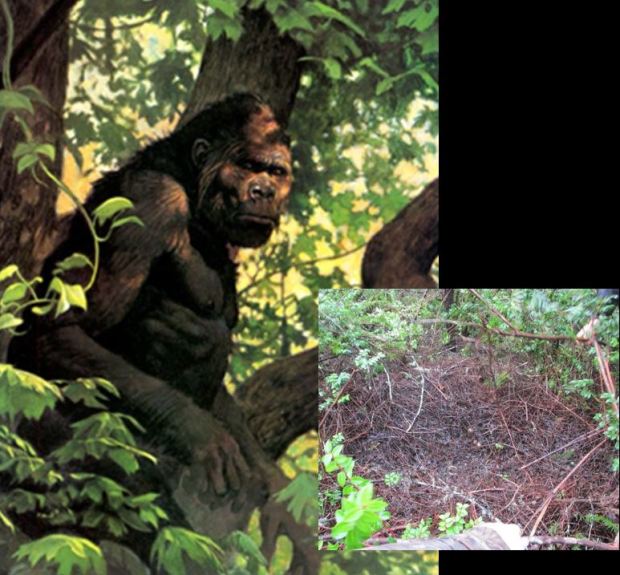
June 23, 2017
From Dr. Jeff Meldrum:
An exciting prospect — an opportunity to apply environmental DNA (eDNA) survey to samples taken from a possible sasquatch nest site. eDNA made the headlines when this method was used to identify DNA of the enigmatic and elusive Denisovan hominin from cave deposits where there was no physical or trace evidence of them occupying the cave site. The potential applications of this method to the sasquatch question should be obvious. It may allow us to overcome the historical lack of success extracting DNA from isolated hair samples. You can contribute to this study undertaken in collaboration with molecular anthropologists at NYU.
Go to the Indiegogo site for more details. There are some perks for those who want to participate on a more substantial level to insure this important scientific study is carried out to its conclusion. Be a citizen scientist.
Spread the word!
Environmental DNA (eDNA) analysis of ground nests attributed to sasquatch on Olympic Peninsula.
New methods of surveying all DNA to be found in a soil sample (eDNA) may assist in the search for sasquatch. Soil samples taken from ground nest sites, attributed to sasquatch on the basis of construction and hair samples, are ideal candidates for eDNA analysis. Samples have been collected from nests at a site in the Olympic Peninsula, WA and await analysis. Cost is approximately $1000 per sample.
A vexing obstacle in the search for sasquatch has been the inability to successfully extract and sequence DNA from hair samples attributed to sasquatch on the basis of their distinctive morphology. Recent headlines have expounded the discovery of DNA of the enigmatic Denisovan hominins using environmental DNA (eDNA) survey methods, despite the lack of any physical or trace evidence of Denisovans occupying the cave. The potential for application of eDNA methods to the sasquatch question is obvious.The key to successful results is identifying the appropriate sample site. Recently, members of the Olympic Project, a group of citizen scientist investigators in Washington state, became aware of multiple ground nests of distinctive construction, yielding hairs of an unknown hominoid. Expert opinion is that these unusual nest were not made by bears. This seemed to be an ideal situation for an eDNA survey.
My name is Dr. Jeff Meldrum. I am a professor of anatomy and anthropology at Idaho State University and have considered the question of sasquatch from various angles for over two decades. I was invited by Derek Randles, of the Olympic Project, to visit the site and examine the nests, their location, concentration, and construction. I was stunned. The nests were typically underlain with a foundation of medium diameter sticks overlain with huckleberry boughs that had been apparently manually pulled off the ends of the surrounding bushes that formed and effective 7-foot screen. The boughs were jammed in stem first and plaited into the marginal ring. Soil samples were collected under sterile conditions and await eDNA analysis.
My colleague Dr. Todd Disotell, a molecular anthropologist at New York University, has remained open-minded about the possible existence of sasquatch and has analyzed tissue samples of interest in the past. Dr. Disotell, who first suggested to me the prospects of eDNA as a tool to get at this perplexing objective, has agreed to conduct the surveys this Fall once funding is secured. The cost to carry out the analysis is approximately $1000 per sample.
It should not be surprising that the physical remains of sasquatch have yet to be secured. An extremely rare and reclusive species, solitary, perhaps nocturnal, far ranging, long-lived — these attributes make the discovery challenging. How often does one stumble on a a bear carcass that died a natural death? Or more to the point, something like a wolverine, or a marten? The alignment of these two factors — improvements in eDNA protocols and the identification of what is most likely a sasquatch nesting site — provide a novel opportunity to perhaps finally get the novel DNA sequence we have been searching for. You can participate in this scientific endeavor through your contributions to fund the eDNA analysis.
Go here to contribute to this worthy scientific study!
About Craig Woolheater
Co-founder of Cryptomundo in 2005.
I have appeared in or contributed to the following TV programs, documentaries and films:
OLN's Mysterious Encounters: "Caddo Critter", Southern Fried Bigfoot, Travel Channel's Weird Travels: "Bigfoot", History Channel's MonsterQuest: "Swamp Stalker", The Wild Man of the Navidad, Destination America's Monsters and Mysteries in America: Texas Terror - Lake Worth Monster, Animal Planet's Finding Bigfoot: Return to Boggy Creek and Beast of the Bayou.
Filed under Bigfoot, Bigfoot Report, Crowdsourcing, Cryptozoologists, Cryptozoology, Evidence, Forensic Science, Sasquatch